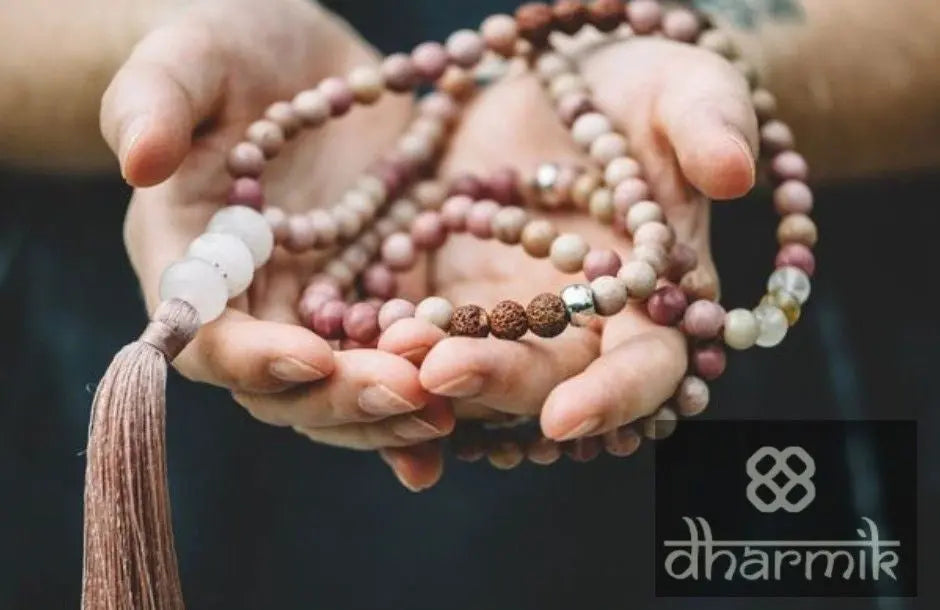
How to Verify the Authenticity of Tulsi Mala
Share
Introduction By: Niyati phogat
Wearing a Tulsi mala is not just a tradition but also a spiritual practice that brings peace, devotion, and positive energy. However, with the growing popularity of these sacred malas, there has also been an increase in fake and machine-made versions in the market. This makes it very important for devotees to know how to check the genuineness of their mala. In this blog, we will guide you step by step on how to verify the authenticity of a Tulsi mala, what signs to look for, and how to ensure that your spiritual practice is supported by a truly sacred item.
Why Authenticity Matters in Tulsi Mala
A Tulsi mala is considered divine in Hinduism and Vaishnavism, as it is believed to be directly connected to Goddess Tulsi. Wearing or chanting with it is said to purify the mind and soul. But if the mala is not authentic, its spiritual benefits may not be the same. Many sellers offer imitations made from plastic or low-quality wood, and these lack the vibration and sanctity of real Tulsi beads. Thus, verifying your mala ensures you receive both spiritual and health benefits.
Physical Characteristics of a Genuine Tulsi Mala
When buying a Tulsi mala, the first step is to check its physical features. Real Tulsi beads are light in weight, usually off-white to pale yellow in color, and have a natural wooden texture. Unlike polished or machine-cut beads, authentic beads may have minor imperfections and unevenness. These small flaws are a sign of natural origin, making each mala unique. Carefully looking at these aspects is an essential part of original verification of the mala.
Comparison: Original vs Fake Tulsi Mala
To make it easier, here is a simple table showing the difference between authentic and duplicate malas:
|
S.no. |
Feature |
Original Tulsi Mala |
Fake Tulsi Mala |
|
1. |
Weight |
Very light, almost weightless |
Heavier, feels dense |
|
2. |
Texture |
Pale yellow, off-white, cream |
Too dark, shiny, or artificial-looking |
|
3. |
Color |
Slightly rough, porous, natural |
Smooth, polished, plastic-like |
|
4. |
Smell |
Mild, natural wooden fragrance |
No smell or chemical like |
|
5. |
Water Test |
Floats on water |
Sinks on water |
|
6. |
Craftsmanship |
Hand-knotted, natural flaws in beads |
Machine-made, too perfect and uniform |
Smell Test for Tulsi Mala
One of the simplest methods to check your Tulsi mala is the smell test. Pure Tulsi wood has a mild, soothing fragrance that you can notice when the beads are rubbed together or slightly heated by hand. If the mala has no fragrance or smells like plastic or varnish, it may not be genuine. This natural aroma is one of the most authentic indicators of purity.

Water Test to Identify Authenticity
Another traditional way to check your Tulsi mala is through the water test. Place the beads in a bowl of water for a few minutes. Real Tulsi beads will remain light in weight and float on water, while artificial or mixed wood malas often sink. This simple home method helps in quick original verification and can save you from investing in fake malas.
Weight and Texture of Genuine Tulsi Beads
A true Tulsi mala is always lighter than malas made from other woods or materials. When you hold it, it should feel almost weightless, creating a calm vibration. The texture is slightly rough and porous, unlike the glossy and smooth surface of plastic or polished wood beads. Checking the weight and texture is one of the most effective ways to confirm whether the mala you have is authentic or not.
Sacred Knotting and Handmade Quality
Handmade malas are more trustworthy than factory-made ones. A Tulsi mala that is genuine is usually strung with hand-knotted threads between each bead. This ensures durability and sanctity. Fake malas are often machine-threaded and lack this spiritual detailing. Paying attention to craftsmanship gives another layer of assurance about authenticity.
Checking with a Spiritual Vendor
Buying your Tulsi mala from a reputed spiritual shop, temple, or certified online store ensures reliability. Trusted sellers provide malas that are already blessed and verified. Some even provide certificates of authenticity, making the process of purchase easier. When shopping online, always look for reviews, customer photos, and brand reputation to avoid counterfeit malas.
Energy Vibration and Spiritual Feel
A true Tulsi mala carries a calming and divine vibration. Many devotees say they can instantly feel positive energy while chanting with authentic beads. If you use the mala regularly and do not feel any change in your focus, peace, or devotion, it may not be genuine. Trusting your spiritual intuition is equally important when verifying the authenticity of a mala.
Common Mistakes People Make
While buying a Tulsi mala, many people focus only on looks and price. But a very cheap mala or one that looks overly polished is usually fake. Another mistake is ignoring the source. Buying from roadside sellers without inquiry often results in getting duplicate malas. Always remember that true devotion should be supported by a real sacred item.
How to Maintain the Purity of Tulsi Mala
After confirming authenticity, maintaining your Tulsi mala is equally important. Keep it clean, avoid using chemicals, and store it in a sacred space. Washing with plain water occasionally and keeping it in a cotton pouch helps maintain its quality. A well-maintained mala retains its vibration and serves you for years in your spiritual journey.
FAQs on Tulsi Mala Authenticity
Q1. How can I quickly check if my Tulsi mala is genuine?
A quick check can be done through the water test—real Tulsi beads float while fake ones sink.
Q2. What color should original Tulsi beads be?
Authentic beads are usually off-white, pale yellow, or cream in shade, not dark brown or overly polished.
Q3. Can fake Tulsi malas also be used for chanting?
While chanting is always powerful, fake malas made from plastic or other wood do not carry the same spiritual vibrations.
Q4. Where should I buy an authentic Tulsi mala?
It is best to purchase from trusted spiritual stores, temples, or reputed online sellers who provide assurance of authenticity.
Q5. How do I care for my Tulsi mala?
Keep it away from perfumes, oils, and chemicals. Store it in a cloth pouch and wash occasionally with clean water.
Final Thoughts
A Tulsi mala is not just a piece of spiritual jewellary ,it is a sacred companion in devotion and meditation. Ensuring authenticity helps you connect deeply with your practice and experience the true blessings of Goddess Tulsi. By using the above tests such as smell, water, texture, and source verification, you can confidently check whether your mala is original. Remember, spirituality is about purity, and your mala should reflect that in every way.
